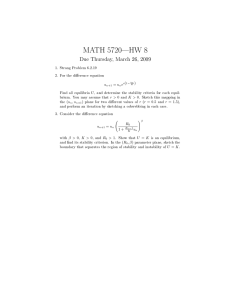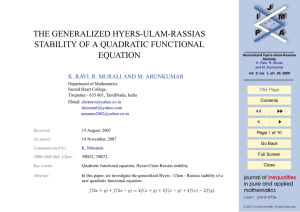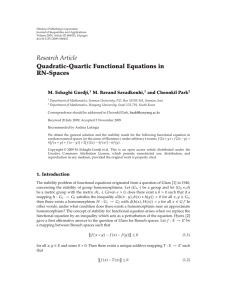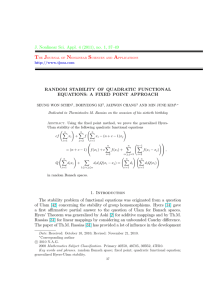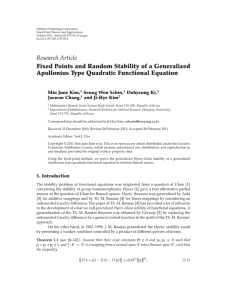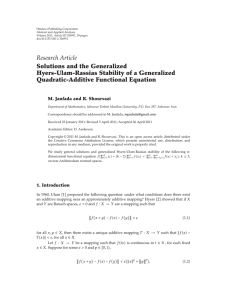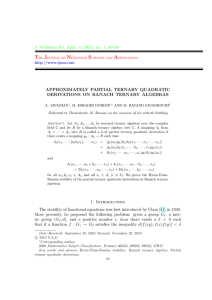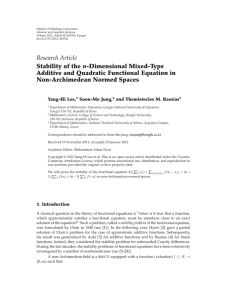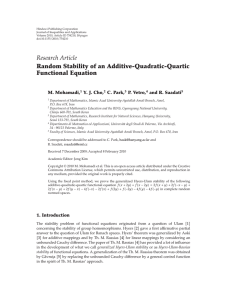Document 10816879
advertisement
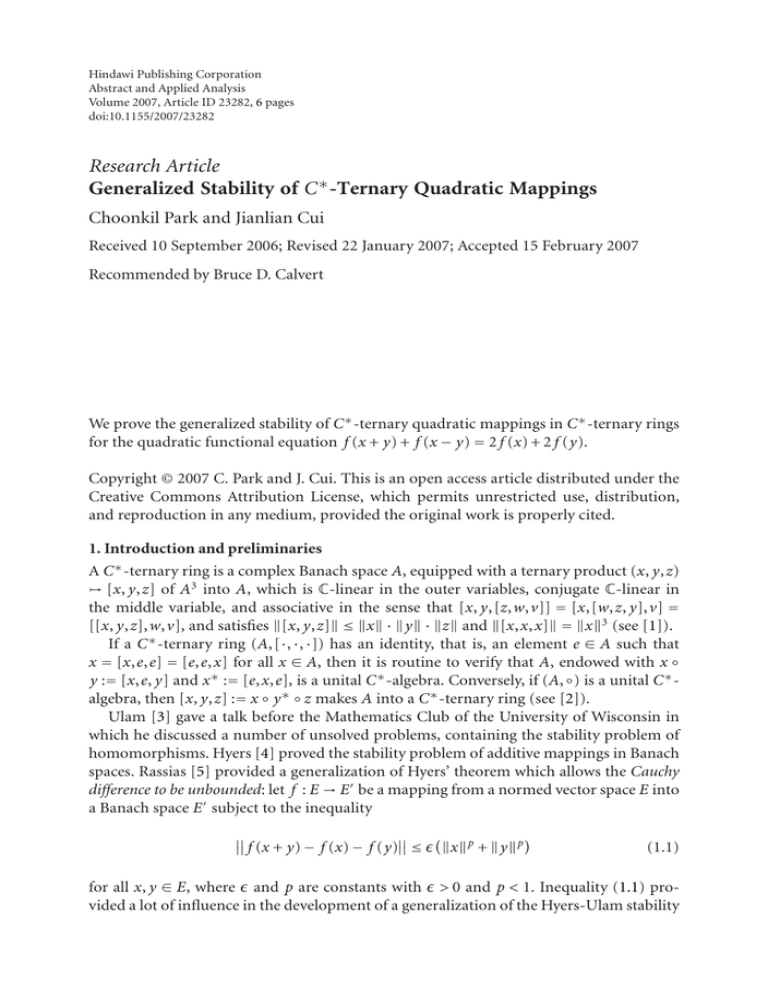
Hindawi Publishing Corporation
Abstract and Applied Analysis
Volume 2007, Article ID 23282, 6 pages
doi:10.1155/2007/23282
Research Article
Generalized Stability of C ∗ -Ternary Quadratic Mappings
Choonkil Park and Jianlian Cui
Received 10 September 2006; Revised 22 January 2007; Accepted 15 February 2007
Recommended by Bruce D. Calvert
We prove the generalized stability of C ∗ -ternary quadratic mappings in C ∗ -ternary rings
for the quadratic functional equation f (x + y) + f (x − y) = 2 f (x) + 2 f (y).
Copyright © 2007 C. Park and J. Cui. This is an open access article distributed under the
Creative Commons Attribution License, which permits unrestricted use, distribution,
and reproduction in any medium, provided the original work is properly cited.
1. Introduction and preliminaries
A C ∗ -ternary ring is a complex Banach space A, equipped with a ternary product (x, y,z)
→ [x, y,z] of A3 into A, which is C-linear in the outer variables, conjugate C-linear in
the middle variable, and associative in the sense that [x, y,[z,w,v]] = [x,[w,z, y],v] =
[[x, y,z],w,v], and satisfies [x, y,z] ≤ x · y · z and [x,x,x] = x3 (see [1]).
If a C ∗ -ternary ring (A,[·, ·, ·]) has an identity, that is, an element e ∈ A such that
x = [x,e,e] = [e,e,x] for all x ∈ A, then it is routine to verify that A, endowed with x ◦
y := [x,e, y] and x∗ := [e,x,e], is a unital C ∗ -algebra. Conversely, if (A, ◦) is a unital C ∗ algebra, then [x, y,z] := x ◦ y ∗ ◦ z makes A into a C ∗ -ternary ring (see [2]).
Ulam [3] gave a talk before the Mathematics Club of the University of Wisconsin in
which he discussed a number of unsolved problems, containing the stability problem of
homomorphisms. Hyers [4] proved the stability problem of additive mappings in Banach
spaces. Rassias [5] provided a generalization of Hyers’ theorem which allows the Cauchy
difference to be unbounded: let f : E → E be a mapping from a normed vector space E into
a Banach space E subject to the inequality
f (x + y) − f (x) − f (y) ≤ x p + y p
(1.1)
for all x, y ∈ E, where and p are constants with > 0 and p < 1. Inequality (1.1) provided a lot of influence in the development of a generalization of the Hyers-Ulam stability
2
Abstract and Applied Analysis
concept. Găvruţa [6] provided a further generalization of Hyers-Ulam theorem (see [7,
8]).
A square norm on an inner product space satisfies the important parallelogram equality
x + y 2 + x − y 2 = 2 x 2 + 2 y 2 .
(1.2)
f (x + y) + f (x − y) = 2 f (x) + 2 f (y)
(1.3)
The functional equation
is called the quadratic functional equation whose solution is said to be a quadratic mapping. A generalized stability problem for the quadratic functional equation was
proved by Skof [9] for mappings f : E1 → E2 , where E1 is a normed space and E2 is a
Banach space. Cholewa [10] noticed that the theorem of Skof is still true if the relevant
domain E1 is replaced by an Abelian group. Czerwik [11] proved the generalized stability of the quadratic functional equation, and Park [12] proved the generalized stability of
the quadratic functional equation in Banach modules over a C ∗ -algebra. Jun and Lee [13]
proved the further generalized stability of a Pexiderized quadratic functional equation
f (x + y) + g(x − y) = 2h(x) + 2k(y).
(1.4)
Recently, a fixed point approach to the stability of Pexiderized quadratic equation was
established by Mirzavaziri and Moslehian [14].
Throughout this paper, assume that A is a C ∗ -ternary ring with norm · A and that
B is a C ∗ -ternary ring with norm · B .
A quadratic mapping Q : A → B is called a C ∗ -ternary quadratic mapping if
Q [x, y,z] = Q(x),Q(y),Q(z)
(1.5)
for all x, y,z ∈ A.
Example 1.1. Let (A,[·, ·, ·]) be a C ∗ -ternary ring derived from a unital commutative
C ∗ -algebra A, and let Q : A → A satisfy Q(x) = x2 for all x ∈ A. It is easy to show that the
mapping Q : A → A is a C ∗ -ternary quadratic mapping.
In this paper, we prove the further generalized stability of C ∗ -ternary quadratic mappings in C ∗ -ternary rings.
2. Stability of C ∗ -ternary quadratic mappings
We prove the further generalized stability of C ∗ -ternary quadratic mappings in C ∗ ternary rings for the quadratic functional equation
Q(x + y) + Q(x − y) = 2Q(x) + 2Q(y).
(2.1)
C. Park and J. Cui 3
Theorem 2.1. Let f : A → B be a mapping for which there exists a function ϕ : A3 → [0, ∞)
such that
∞
43 j ϕ
j =0
x y z
, ,
< ∞,
2j 2j 2j
(2.2)
f (x + y) + f (x − y) − 2 f (x) − 2 f (y) ≤ ϕ(x, y,0),
B
f [x, y,z] − f (x), f (y), f (z) ≤ ϕ(x, y,z)
B
(2.3)
(2.4)
for all x, y,z ∈ A. Then there exists a unique C ∗ -ternary quadratic mapping Q : A → B such
that
x x
f (x) − Q(x) ≤ ϕ
,
,0
B
(2.5)
2 2
for all x ∈ A. Here,
ϕ(x,
y,z) :=
∞
4jϕ
j =0
x y z
, ,
2j 2j 2j
(2.6)
for all x, y,z ∈ A.
Proof. If follows from (2.3) that f (0) = 0. Letting y = x in (2.3), we get
f (2x) − 4 f (x) ≤ ϕ(x,x,0)
B
(2.7)
f (x) − 4 f x ≤ ϕ x , x ,0
2 2 2
(2.8)
for all x ∈ A. So
B
for all x ∈ A. Hence,
m
−1 m
−1
l
j
x
x x
j
4 f x − 4 m f x ≤
4 f x − 4 j+1 f
≤
4
ϕ
,
,0
2l
2m 2j
2 j+1 2 j+1 2 j+1
B
B
j =l
j =l
(2.9)
for all nonnegative integers m and l with m > l and all x ∈ A. It follows from (2.9) that
the sequence {4n f (x/2n )} is a Cauchy sequence for all x ∈ A. Since B is complete, the
sequence {4n f (x/2n )} converges. So one can define the mapping Q : A → B by
Q(x) := lim 4n f
n→∞
x
2n
(2.10)
for all x ∈ A. Moreover, letting l = 0 and passing the limit m → ∞ in (2.9), we get (2.5).
4
Abstract and Applied Analysis
It follows from (2.3) that
Q(x + y) + Q(x − y) − 2Q(x) − 2Q(y)
B
x+y
x−y
y x
= lim 4n f
+
f
2
f
2
f
−
−
n
n
n
n→∞
2
2
2
2 n B
x y
≤ lim 4n ϕ n , n ,0 = 0
n→∞
(2.11)
2 2
for all x, y ∈ A. So
Q(x + y) + Q(x − y) = 2Q(x) + 2Q(z)
(2.12)
for all x, y ∈ A.
It follows from (2.4) and the continuity of the ternary product that
Q [x, y,z] − Q(x),Q(y),Q(z) B
[x, y,z]
y
x
z
3n = lim 4 f
,f n ,f n − f
n→∞
23n
2n
2
2
≤ lim 43n ϕ
n→∞
B
(2.13)
x y z
, ,
=0
2n 2n 2n
for all x, y,z ∈ A. So
Q [x, y,z] = Q(x),Q(y),Q(z)
(2.14)
for all x, y,z ∈ A.
Now, let T : A → B be another quadratic mapping satisfying (2.5). Then we have
Q(x) − T(x) = 4n Q x − T x B
n
n 2
2
B
x
x + T x − f x ≤ 4n Q
f
−
n
n
n
n
2
2
2
2 B
x x
≤ 2 · 4n ϕ n , n ,0 ,
B
(2.15)
2 2
which tends to zero as n → ∞ for all x ∈ A. So we can conclude that Q(x) = T(x) for
all x ∈ A. This proves the uniqueness of Q. Thus, the mapping Q : A → B is a unique
C ∗ -ternary quadratic mapping satisfying (2.5).
Theorem 2.2. Let f : A → B be a mapping for which there exists a function ϕ : A3 → [0, ∞)
satisfying (2.3) and (2.4) such that
ϕ(x,
y,z) :=
∞
1 j =0
ϕ
4j
2 j x,2 j y,2 j z < ∞
(2.16)
C. Park and J. Cui 5
for all x, y,z ∈ A. Then there exists a unique C ∗ -ternary quadratic mapping Q : A → B such
that
f (x) − Q(x) ≤ 1 ϕ(x,x,0)
B
(2.17)
4
for all x ∈ A.
Proof. It follows from (2.7) that
f (x) − 1 f (2x) ≤ 1 ϕ(x,x,0)
4
4
B
(2.18)
for all x ∈ A. So
m
−1 m
−1
1 l 1 j 1 j j f 2 x − 1 f 2m x ≤
f 2 x − 1 f 2 j+1 x ≤
ϕ 2 x,2 x,0
4l
j
j+1
m
4
4
4
4 j+1
B
B
j =l
j =l
(2.19)
for all nonnegative integers m and l with m > l and all x ∈ A. It follows from (2.19) that
the sequence {(1/4n ) f (2n x)} is a Cauchy sequence for all x ∈ A. Since B is complete, the
sequence {(1/4n ) f (2n x)} converges. So one can define the mapping Q : A → B by
Q(x) := lim
1 n f 2 x
(2.20)
n→∞ 4n
for all x ∈ A. Moreover, letting l = 0 and passing the limit m → ∞ in (2.19), we get (2.17).
It follows from (2.4) and the continuity of the ternary product that
Q [x, y,z] − Q(x),Q(y),Q(z) = lim
B
1 f 23n [x, y,z] − f 2n x , f 2n y , f 2n z B
n→∞ 43n
(2.21)
1 n n n ϕ 2 x,2 y,2 z
n→∞ 43n
≤ lim
≤ lim
1 n n n ϕ 2 x,2 y,2 z = 0
n→∞ 4n
for all x, y,z ∈ A. So
Q [x, y,z] = Q(x),Q(y),Q(z)
for all x, y,z ∈ A.
The rest of the proof is similar to the proof of Theorem 2.1.
(2.22)
Remark 2.3. For a Pexiderized quadratic functional equation
f (x + y) + g(x − y) = 2h(x) + 2k(y),
one can obtain similar results to Theorems 2.1 and 2.2.
(2.23)
6
Abstract and Applied Analysis
Acknowledgments
The first author was supported by Grant no. F01-2006-000-10111-0 from the Korea Science and Engineering Foundation and the second author was supported by National Natural Science Foundation of China (no.10501029), Tsinghua Basic Research Foundation
(JCpy2005056), and the Specialized Research Fund for Doctoral Program of Higher Education.
References
[1] H. Zettl, “A characterization of ternary rings of operators,” Advances in Mathematics, vol. 48,
no. 2, pp. 117–143, 1983.
[2] M. S. Moslehian, “Almost derivations on C ∗ -ternary rings,” Bulletin of the Belgian Mathematical
Society Simon Stevin, vol. 14, pp. 135–142, 2007.
[3] S. M. Ulam, A Collection of Mathematical Problems, Interscience Tracts in Pure and Applied
Mathematics, no. 8, Interscience Publishers, New York, NY, USA, 1960.
[4] D. H. Hyers, “On the stability of the linear functional equation,” Proceedings of the National
Academy of Sciences of the United States of America, vol. 27, no. 4, pp. 222–224, 1941.
[5] Th. M. Rassias, “On the stability of the linear mapping in Banach spaces,” Proceedings of the
American Mathematical Society, vol. 72, no. 2, pp. 297–300, 1978.
[6] P. Găvruţa, “A generalization of the Hyers-Ulam-Rassias stability of approximately additive
mappings,” Journal of Mathematical Analysis and Applications, vol. 184, no. 3, pp. 431–436,
1994.
[7] C. Park, “Isomorphisms between C ∗ -ternary algebras,” Journal of Mathematical Physics, vol. 47,
no. 10, Article ID 103512, 12 pages, 2006.
[8] C. Park, “Isomorphisms between C ∗ -ternary algebras,” Journal of Mathematical Analysis and
Applications, vol. 327, no. 1, pp. 101–115, 2007.
[9] F. Skof, “Proprietà locali e approssimazione di operatori,” Rendiconti del Seminario Matematico
e Fisico di Milano, vol. 53, pp. 113–129, 1983.
[10] P. W. Cholewa, “Remarks on the stability of functional equations,” Aequationes Mathematicae,
vol. 27, no. 1, pp. 76–86, 1984.
[11] St. Czerwik, “On the stability of the quadratic mapping in normed spaces,” Abhandlungen aus
dem Mathematischen Seminar der Universität Hamburg, vol. 62, pp. 59–64, 1992.
[12] C. Park, “On the stability of the quadratic mapping in Banach modules,” Journal of Mathematical
Analysis and Applications, vol. 276, no. 1, pp. 135–144, 2002.
[13] K.-W. Jun and Y.-H. Lee, “On the Hyers-Ulam-Rassias stability of a Pexiderized quadratic inequality,” Mathematical Inequalities & Applications, vol. 4, no. 1, pp. 93–118, 2001.
[14] M. Mirzavaziri and M. S. Moslehian, “A fixed point approach to stability of a quadratic equation,” Bulletin of the Brazilian Mathematical Society. New Series, vol. 37, no. 3, pp. 361–376, 2006.
Choonkil Park: Department of Mathematics, Hanyang University, Seoul 133-791, South Korea
Email address: baak@hanyang.ac.kr
Jianlian Cui: Department of Mathematical Sciences, Tsinghua University, Beijing 100084, China
Email address: jcui@math.tsinghua.edu.cn
